

When Paul first arrived in Corinth in the middle of his second missionary journey, Acts 18:2-3 reports that he joined Aquila and Priscilla in the occupation of making tents. This fits in well with 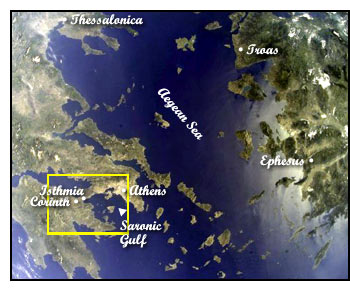 what Paul himself wrote at about that same time. For example, in 1 Thess. 1:9, he says: "Surely you remember, brothers, our toil and hardship; we worked night and day in order not to be a burden to anyone while we preached the gospel of God to you." Similarly, in 2 Thess. 3:7-8, Paul states: "We were not idle when we were with you, nor did we eat any one's food without paying for it. On the contrary, we worked night and day, laboring and toiling so that we would not be a burden to any of you.”
what Paul himself wrote at about that same time. For example, in 1 Thess. 1:9, he says: "Surely you remember, brothers, our toil and hardship; we worked night and day in order not to be a burden to anyone while we preached the gospel of God to you." Similarly, in 2 Thess. 3:7-8, Paul states: "We were not idle when we were with you, nor did we eat any one's food without paying for it. On the contrary, we worked night and day, laboring and toiling so that we would not be a burden to any of you.”
Paul made both of these statements while still in Corinth. Shortly after having left Corinth, toward the end of the third missionary journey, Paul describes his apostolic right to be supported by those he has benefited spiritually (1 Cor. 9). He asks the ironic, rhetorical question, "Or is it only I and Barnabas who must work for a living?" (1 Cor. 9: 6).
According to Jerome Murphy-O'Connor:
-
At first sight the trade of tentmaker with appear particularly inappropriate for one whose ministry focused on cities, but there was a tendency among artisans of the period to use specialized titles, even when there were actually covered a much broader range…, much in the same way as a carpenter of today will sometimes describe himself as a cabinet-maker. Paul was in all probability a leather-worker who could turn his hand to the production of the wide variety of articles made of this material: [sandals], gourds for water and wine, harness, saddles, shields, etc. Tents were also made from leather and a ready market would have existed at Corinth (St. Paul's Corinth: Texts and Archaeology, 168).
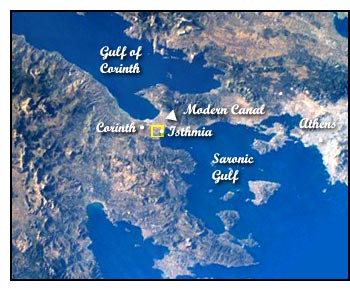 One reason this is true is because the Isthmian Games were held at nearby Isthmia. Second only to the Olympic Games themselves among the four great Panhellenic games, the Isthmian Games were held twice as often as the others, every two years. By the time Paul arrived in Corinth, the Isthmian Games were 500 years old. They had not been interrupted even during the century that its traditional host Corinth lay virtually abandoned (146-44 B.C.).
One reason this is true is because the Isthmian Games were held at nearby Isthmia. Second only to the Olympic Games themselves among the four great Panhellenic games, the Isthmian Games were held twice as often as the others, every two years. By the time Paul arrived in Corinth, the Isthmian Games were 500 years old. They had not been interrupted even during the century that its traditional host Corinth lay virtually abandoned (146-44 B.C.).
At about the time Paul arrive in Corinth, 50 C.E., the games were moved back to Isthmia from Corinth. Another festival, the Caesarean Games, was held concurrently with every other occurrence of the Isthmian Games. It featured its own venue of events. Throngs of people from all over the Roman Empire flocked to Isthmia, either to participate in or to watch the competitions. According to Dio, a contemporary of Paul (in his Orations 8.12), the basic athletic events of the Isthmian Games included foot races, wrestling, jumping, boxing, hurling the javelin, and throwing the discus.
At one time or another in the history of the games, additional events included horse racing, chariot races, poetry reading, drama, singing, heralding, playing the lyre and the flute, and a painting competition. Yacht races in the nearby Saronic Gulf gave the games a feature not found at Olympia, Delphi, or Nemea. Events were scheduled for women as well as men, and also for children. Large amounts of money changed hands, not only from the gamblers who won and lost, but also from those who showered gifts upon the victors.

Excavations of Isthmia began in 1883 under Paul Monceaux. They were renewed in 1930 by B. S. Jenkins and H. Megaw. These early efforts yielded only meager results. Oscar Broneer, however, who excavated the site from 1959 to 1967, uncovered the temple of Poseidon, porticoes, the sanctuary of Palaemon, two stadiums, one much earlier than the other, and a Hellenistic settlement at nearby “Rachi.” One of Broneer’s assistants, Elizabeth Gebhard, excavated the theater. From 1967 to 1976, P. Clement excavated the Roman baths and other buildings. Ms. Gebhard returned in 1980 and 1989 to excavate the central shrine and a prehistoric settlement at “Rachi.”
Archaeologists could find no trace of permanent accommodations for the crowds attending the games as early as the First Century C.E. These 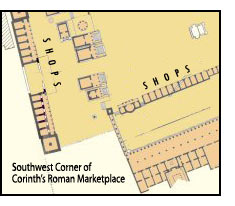 were only built in the Second Century. Faced with the choice of either having to walk several miles a day to witness the events or purchasing and pitching a tent, hundreds, if not thousands, would prefer the latter. In other words, Corinth may have been one of the best places in the Mediterranean world for Paul to open a tentmaker’s shop. Small shops such as his (about 10 feet by 10 feet) lined the marketplaces in Hellenistic cities throughout the Empire.
were only built in the Second Century. Faced with the choice of either having to walk several miles a day to witness the events or purchasing and pitching a tent, hundreds, if not thousands, would prefer the latter. In other words, Corinth may have been one of the best places in the Mediterranean world for Paul to open a tentmaker’s shop. Small shops such as his (about 10 feet by 10 feet) lined the marketplaces in Hellenistic cities throughout the Empire.
Did Paul attend the games while he lived in Corinth? We have no way of knowing for sure. The games were opened with a sacrifice to Poseidon as the resident patron deity. In addition, many of the athletic contests were performed in the nude for the men, and women athletes probably wore only the scantiest of outfits. We would expect such immodesty to offend Jewish/Christian scruples. Yet, Murphy-O'Connor states:
- It is difficult to decide if Paul himself attended the games. Palestinian Jewish opposition to such spectacles is well documented..., but we cannot assume that the same attitude prevailed in the Diaspora. If Philo felt himself free to attend an all-in wrestling contest (Quod omnis probis, 26) we can be sure that many Hellenized Jews had no compunction about attending the games. Jews had specially reserved seats in the theater at Miletus in western Asia Minor…(17).
What we do know for sure, is that Paul uses familiarity with the games as a source of imagery in his teaching. An examination his speeches and letters in roughly chronological order reveals a number of allusions to athletic competition. (I will make the allusions bold and provide more literal translations when helpful.)
Before arriving in Corinth, in a sermon delivered in Antioch of Pisidia (Acts 13:25), Paul uses “(race) course” (Greek: dromos, the word behind “rollerdrome” and “hippodrome”) as a metaphor for God’s purpose for the life of John the Baptizer: “And while John was completing his course, he kept saying, 'Who do you suppose that I am? I am not He.’”
Years later, Paul would use the same imagery again to refer to his own purpose in life. When he bids farewell to the Ephesian elders (Acts 20:24), Paul says: “However, I consider my life worth nothing to me, if only I may finish the course and complete the ministry which I have received from the Lord Jesus—to testify to the gospel of God’s grace.”
In Galatians 2:2, as Paul describes an early visit to Jerusalem, he writes, "I... set before them the gospel that I preached among the Gentiles. But I did this privately to those who seemed to be leaders, for fear that I was running or had run my race in vain." Later, in the same book (5:7), he observes, "You were running a good race. Who cut in on you and kept you from obeying the truth?"
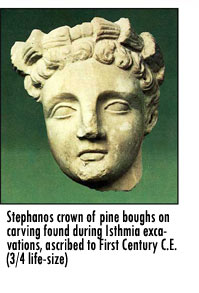 These metaphors Paul employed before he ever arrived in Corinth. The longest passage, however, occurs in First Corinthians 9:24-27. Shortly after completing his church-founding visit in Corinth, Paul urges the Corinthians:
These metaphors Paul employed before he ever arrived in Corinth. The longest passage, however, occurs in First Corinthians 9:24-27. Shortly after completing his church-founding visit in Corinth, Paul urges the Corinthians:
-
Do you not know that in a race all the runners run, but only one gets the prize? Run in such a way as to get the prize. Everyone who competes in the games goes into strict training. They do it to get a crown that will not last; but we do it to get a crown that will last forever. Therefore I do not run like a man running aimlessly; I did not fight like a man beating the air. No, I beat my body and make it my slave so that after I have preached to others, I myself will not become disqualified.

In prior centuries, incidentally, the crown (Greek: stephanos) awarded as a prize at Isthmia was made of pine boughs, as illustrated on the reverse side of contemporary coins and in carvings found at Isthmia. The pine bough wreath continued to be the iconic symbol of the Isthmian Games, even though evidence exists that another plant, selinon (an herb similar to celery or parsley) was used in the First Century C.E. A votive carving celebrating Isthmian victories shows crowns made from a variety of plants, including both pine and selinon. This fits particularly well with the phrase, "crown that will not last," or, more literally, "perishable crown." By the time the Isthmian athletes received their herbal crown, it was already wilted.
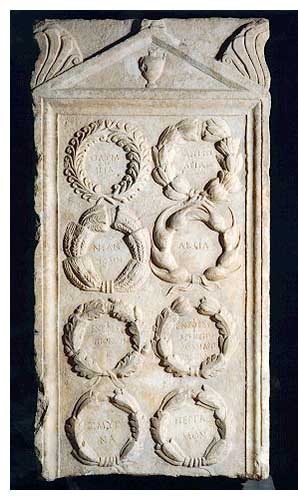 In several of Paul’s letters he uses the word “struggle” or “contest” (Greek: agon-, from which we get “agony” and “agonize”). In Rom. 15:30, for example, “I urge you, brothers, by our Lord Jesus Christ and by the love of the Spirit, to join me in my struggle by praying to God for me.” Similar passages occur in the letters Paul later wrote from prison (see Eph. 6:12; Col. 1:29; 2:1; 4:12; Phil. 1:30) and in one he wrote after he was released (1 Tim. 4:10; 6:12).
In several of Paul’s letters he uses the word “struggle” or “contest” (Greek: agon-, from which we get “agony” and “agonize”). In Rom. 15:30, for example, “I urge you, brothers, by our Lord Jesus Christ and by the love of the Spirit, to join me in my struggle by praying to God for me.” Similar passages occur in the letters Paul later wrote from prison (see Eph. 6:12; Col. 1:29; 2:1; 4:12; Phil. 1:30) and in one he wrote after he was released (1 Tim. 4:10; 6:12).
In one of those same prison letters (Phil. 3:13-14), Paul applies race imagery to his own experience: “But one thing I do: Forgetting what is behind and straining toward what is ahead, I press on toward the goal to win the prize for which God has called me heavenward in Christ Jesus.”
The word translated “prize” (Greek: brabeion) is one of at least three Greek words used to describe the prize awarded to the winner of a contest. The context indicates that what Paul is referring to forgetting his past accomplishments, not his past failures. Contrary to how many preachers use it, this verse is not saying, “Don’t let your past failures discourage you from winning.” It says the opposite: “Don’t rely on your ‘track record’ of achievements.” Every race is a brand new race, and all the runners, even the champions, must prove their worth all over again.”
When Paul is imprisoned once more, just before his execution, he writes in his final letter (2 Tim. 4:7-8):
-
I have fought the good fight (agone); I have completed the course (dromos); I have kept the faith. What remains is for me to be awarded the crown (stephanos) of righteousness, which the Lord will convey to me on that day, being a righteous judge; and not only will he give it to me, but also to all of those who love his manifestation.
Just as even in modern times, the highest-ranking official present has the honor of handing out the awards, so Paul anticipates that Jesus will award him his crown for his victory in the Christian “race.”
All of this can be reduced to a few principles, a few “ground rules”:
- Despite Christ’s victory at the cross and his provision of forgiveness as a result, the Christian life continues to be a contest between good and evil. It is a wrestling match with the devil in which the stakes are high, and the risk of losing is real (Eph. 6:12).
- God wants us to win this contest, and He has made every provision for our success. Yet we ourselves must be willing to undergo discipline and submit to rigorous training if we are going to receive the prize (1 Cor. 9:24-25).
- God has set out the course He wants us to follow (Acts 20:24). The boundaries of the course He has marked out by His moral will—we move outside the boundaries when we commit sins or “trespasses.” Within those moral limits, however, we have considerable freedom to exercise our own judgment on how best to “run our race” (2 Tim. 4:7).
- Death is the finish line and life with Christ in eternity the prize (Phil. 3:13-14; 2 Tim. 4:8).
- In a real sense, we are already winners as soon as we begin the race. In the words of Paul, we are “super-victorious” through him who loved us” (Rom. 8:37). Yet, we must still run the race and avoid getting disqualified (1 Cor. 9:26-27).
Where are you in your Christian race? Are you at the starting blocks? Perhaps you are rounding the last curve and staring at the finish-line up ahead. Or maybe you’re still in the bleachers watching others running the race. Wherever you are, God’s challenge is for you to get in the race, to run with all you’ve got, and to cross the finish-line victorious. He will enable you, equip you, and train you. But you must do your part: take your Christian life seriously, read up on the “rules,” and listen to and obey your Coach. Then RUN!
Want to dive deeper?
Here are some recommended sources:
1962 Oscar Broneer. “The Isthmian Victory Crown.” American Journal of Archaeology. 66:259ff. (See also Broneer's many other writings on Isthmia.)
1967 Pfitzner, Victor C. Paul and the Agon Motif: Traditional athletic imagery in the Pauline literature. Leiden: E.J. Brill. (doctoral dissertation for the Evangelical Theological Faculty of Münster, Westphalia, Germany)
1973 Elizabeth Gebhard. The Theater at Isthmia. Chicago: University of Chicago.
1983 Jerome Murphy-O’Connor. St. Paul’s Corinth: Texts and Archaeology. Wilmington, DE: Michael Glazier.
Online resources:
- Elizabeth R. Gebhard. “The Isthmian Games and the Sanctuary of Poseidon in the Early Empire.”
- Corinth Computer Project
- University of Chicago excavations at Isthmia

It has never been easier than today to learn New Testament Greek. The number of study tools available online simply amazing. For example, you can access this online Greek New Testament (Nestle-Aland, 26th ed.). My only gripe with it is that it does not have paragraphing. Every verse is a separate paragraph.
If you are not far enough along to read the Greek text without help, here is a beautiful online Greek-English interlinear New Testament. This features an uncial font, but except for the sigma (which looks like a "C"), most of the letters are close enough to their modern-font counterparts to be recognizable. It also features a transliteration of the Greek characters into their Latin-alphabet equivalents, which should make it handy if you do not yet know the Greek alphabet.
You may be familiar with the Greek dictionary at the back of Strong's Concordance, which has a numbered list of the Greek vocabulary of the New Testament and associates those numbers with all of the New Testament English words in the concordance. If you want to skip the "middle-man," however, and key in the Greek word directly, you will appreciate this Greek concordance.
Once you are able to read the characters of the Greek alphabet, you will want to start your vocabulary drills. Here is a wonderful free download of Greek flashcards. You will want to download and install the fonts as well.
I'll share more online Greek study tools as we go along.
If you are right at the "starting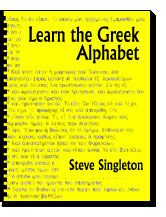 line" in your study of Greek, send for my self-study guide Learn the Greek Alphabet, which I used successfully for several years in getting my New Testament Greek students up to speed in a fun and easy-to-remember way. It uses familiar Scripture songs, such as "Seek ye first," "Rejoice in the Lord always," and a number of others to help you learn how to pronounce New Testament verses in Greek by singing them. In the process of all the fun, it teaches you the pronunciation of all 24 letters of the Greek alphabet, as well as all seven diphthongs (two-letter vowel combinations).
line" in your study of Greek, send for my self-study guide Learn the Greek Alphabet, which I used successfully for several years in getting my New Testament Greek students up to speed in a fun and easy-to-remember way. It uses familiar Scripture songs, such as "Seek ye first," "Rejoice in the Lord always," and a number of others to help you learn how to pronounce New Testament verses in Greek by singing them. In the process of all the fun, it teaches you the pronunciation of all 24 letters of the Greek alphabet, as well as all seven diphthongs (two-letter vowel combinations).
But, wait! That's not all! Here's a bonus: it also has an accenting flowchart that is not available anywhere else. After you use the accenting flowchart again and again, you begin to interalize the steps of proper accenting, and then never have a problem with accenting again. All serious Greek students need this tool!
I only have a few copies of Learn the Greek Alphabet left, so it's "first-come, first-served while supplies last." They are available for only $8.95 plus $3.00 shipping/handling in the U.S. or $6.00 shipping/handling outside the U.S. Order your copy by sending me a check or money order along with your mailing address, and get started on your Greek studies. If they are sold out by the time I receive your money, I will return it to you with an apology and a free e-booklet. Send your order with payment to: DeeperStudy, 1446 Redbud Lane, Garland, TX 75042.

If you like DeeperStudy Newsletter, you’ll love deeperstudy.com. I am building it to encourage more Bible study and to make possible deeper study, giving access to on-line resources for biblical archaeology, cultural background, extra-biblical literature, devotional writings, apologetics, theology, and church fathers. I am also featuring my own writings and biblical studies. Why not take a look at deeperstudy.com right now?
I want to expand my mailing list quickly,
and here's where I could use your help. If you will send me the names 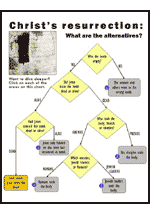 and e-mail addresses of five friends who would like to subscribe to this free Deeperstudy Newsletter, I will send you my Resurrection Flowchart. It sifts through the various alternatives regarding the resurrection of Jesus Christ. Be sure to read all of the "sticky notes" attached to it, assuming you want to "dive deeper." The Resurrection Flowchart is a uniquely designed discussion of the core of the Christian faith. It comes in Adobe Acrobat format and is readable with Adobe Acrobat Reader, a free download
and e-mail addresses of five friends who would like to subscribe to this free Deeperstudy Newsletter, I will send you my Resurrection Flowchart. It sifts through the various alternatives regarding the resurrection of Jesus Christ. Be sure to read all of the "sticky notes" attached to it, assuming you want to "dive deeper." The Resurrection Flowchart is a uniquely designed discussion of the core of the Christian faith. It comes in Adobe Acrobat format and is readable with Adobe Acrobat Reader, a free download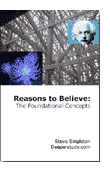 from Adobe. You will want your copy, even if you already sent me the e-mail addresses of five friends to receive last issue's offer, Reasons to Believe: The Fundamental Concepts (which you can still get if you missed it). Find five people you know who could benefit from DeeperStudy Newsletter and send their e-mail addresses today.
from Adobe. You will want your copy, even if you already sent me the e-mail addresses of five friends to receive last issue's offer, Reasons to Believe: The Fundamental Concepts (which you can still get if you missed it). Find five people you know who could benefit from DeeperStudy Newsletter and send their e-mail addresses today.
Unsubscribe me
Privacy
policy: Any information DeeperStudy gathers about you will be used solely to
serve you better. It will not be shared with, rented to, or sold to anyone for any purpose whatsoever. Never! Period!
Copyright ©2004 Steve Singleton. All rights reserved.
